“I do not think there is any thrill that can go through the human heart like that felt by the inventor as he sees some creation of the brain unfolding to success”
Nikola Tesla
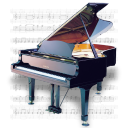
About
The Kundalini Piano Mirror is a system for real-time transposition (remapping) of midi messages that is designed for use with a standard midi piano keyboard to facilitate playing using symmetrical inversion.
The remapping performed results in changing which pitches are produced from which keys on the piano keyboard, making novel ways of playing the keyboard possible.
Specifically, the Piano Mirror software makes it possible to either mirror left-handed passages into the right hand, mirror right-handed passages into the left hand, or to completely reverse the keyboard such that the left hand plays the original right-hand part in mirror image, while the left hand simultaneously plays the original right-hand part in mirror image.
These three remapping types are referred to as Left Hand Ascending Mode, Right Hand Descending Mode, and Mirror Image Mode.
Before covering each mode, let’s first provide some background.
Symmetrical Inversion
The Kundalini Piano Mirror software program is designed to facilitate keyboard playing using symmetrical inversion. This means that either one or both hands are going to be playing the mirror image of what they normally would.
This is possible because the piano keyboard (as well as our hands!) are symmetrical:
(As an aside, if you are interested to read about how I made the animation above, please see this post where I describe its implementation, explain the “creator mindset”, and attempt to convey the joy of programming (“creating”) to those who haven’t found it yet.)

The following table shows the correspondences for each semitone:
| Original Note: | Becomes when symmetrically inverted: |
| D | D |
| C# | D# |
| C | E |
| B | F |
| A# | F# |
| A | G |
| G# | G# |
| G | A |
| F# | B♭ |
| F | B |
| E | C |
| D# | C# |
To facilitate learning to play in this manor, the use of Symmetrically-Inverted Notation is recommended.
Symmetrically-Inverted Notation
Symmetrically-Inverted Notation is simply notation in which one clef is written in standard notation, while the other clef is written using symmetrical inversion, or mirror image:
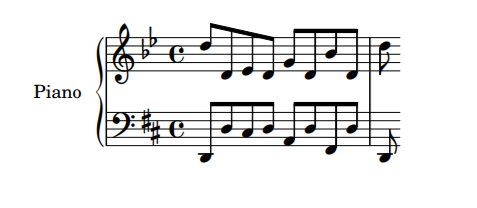
The example above shows a D-Major chord pattern notated in standard notation in the left hand, but notated using symmetrically-inverted notation in the right hand: each note in the right hand is the mirror image of the original note in the left hand.
Further, the cleff written using symmetrical inversion is notated using a key signature which has the same number of sharps as the clef in standard notation has flats, or, the same number of flats as the clef in standard notation has sharps, if the clef in standard notation is written using sharps.
Consulting the circle of fifths can help us understand this, because it can be seen that for each key, there is a corresponding key that both features the same number of accidentals, and whose pattern of accidentals is the mirror image of the original key’s:
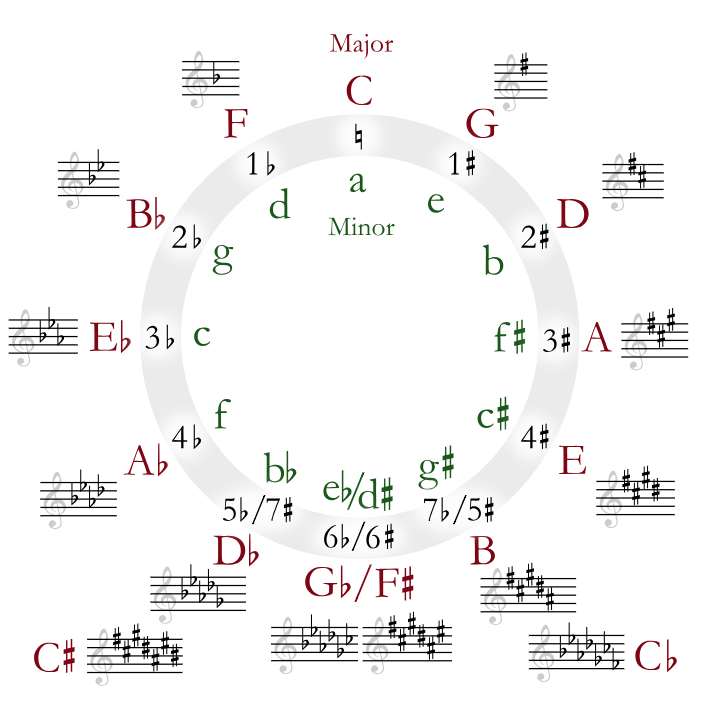
File:Circle of fifths deluxe 4.svg. (2019, January 3). Wikimedia Commons, the free media repository. Retrieved 06:11, February 17, 2019 from https://commons.wikimedia.org/w/index.php?title=File:Circle_of_fifths_deluxe_4.svg&oldid=333331774.
The following table makes this clear:
| Original Key | Becomes |
| C | C |
| G (F#) | F (B♭ – which is the mirror image of F#) |
| D (F#, C#) | B♭ (B♭, E♭ – which are the mirror images of F# and C#) |
| A (etc) | E♭ (etc) |
| E | A♭ |
| B / C♭ | D♭ / C# |
| G♭ / F# | G♭ / F# |
| D♭ | B / C♭ |
| A♭ | E |
| E♭ | A |
| B♭ | D |
| F | G |
The goal of using symmetrically inverted notation is to facilitate reading, because it allows the hand written in mirror image to be notated without undue accidentals; in fact, any accidentals present will exactly mirror those present in the clef in standard notation!
Once you start to get the hang out it, reading music notated in this way becomes second nature.
So with the necessary background information established, let’s return to the three mapping modes used in the Piano Mirror software to facilitate symmetrically-inverted playing.
Left Hand Ascending Mode
Left Hand Descending Mode is designed to practice right hand passages using the left hand, while simultaneously playing the original right hand part with the right hand, such that the right hand guides the left hand naturally.
Normally, when we play a standard piano, as our left hand moves further down (to the left) on the piano, we hear lower notes. Left Hand Ascending Mode, on the other hand, changes this behavior. This mode splits the piano into two halves, separated at what is called the keyboard split point. The keyboard split point defaults to middle D.
Any note above (to the right of) the split point is not changed. Any note below (to the left of) the split point is remapped to correspond to the note an equal interval distance above (to the right of) middle d.
Consider the following musical explanation:

The example above is a standard D Major scale, but notated using symmetrically-inverted notation as described above.
As you can see, both hands start on Middle D, and then proceed at equidistant intervals from that point in both directions. When played on a piano keyboard, this has the interesting property of allowing the two hands to play exactly in mirror image, with the same fingers always being used in each hand on exactly the same interval pattern of white and black keys.
When played on a piano with standard tuning, obviously this produces strange sounds because the intervals between the notes are constantly changing. However, when the passage above is played with Left Hand Ascending Mode active, the pitches sound in unison, as though only the right hand part is being played.
Another way to read the above notation is to consider the bass clef part as specifying only which physical key to play on the keyboard, while the treble indicates both the physical key to play and the produced pitch.
Right Hand Descending Mode
Right Hand Descending Mode is similar to Left Hand Ascending Mode, but is the inverse.
Right Hand Descending Mode is designed to practice left hand passages using the right hand, while simultaneously playing the original left hand part with the left hand, such that the left hand guides the right hand naturally.
Normally, when we play a standard piano, as our right hand moves further up (to the right) on the piano, we hear higher notes. Right Hand Descending Mode, on the other hand, changes this behavior. This mode also splits the piano into two halves, again separated at what is called the keyboard split point, and which again always defaults to middle D.
Any note below (to the left of) the split point is not changed. Any note above (to the right of) the split point is remapped to correspond to the note an equal interval distance below (to the left of) the split point.
The following musical example makes this clear; this time it uses standard notation for the left hand, and symmetrically-inverted notation for the right:

D Major scale, notated for use with Right-Handed Descending Mode
Mirror Image Mode
Finally, mirror image mode is designed create what could be called a left-handed piano. In this mode, the entire keyboard is inverted, such that low notes start on the extreme right, and become higher all the way to the extreme left.
In this configuration, it is possible to play the mirror image of the original right-hand part with the left hand, while simultaneously playing the mirror image of the original left-hand part with the right hand.
Consider the following musical example, written using standard notation:
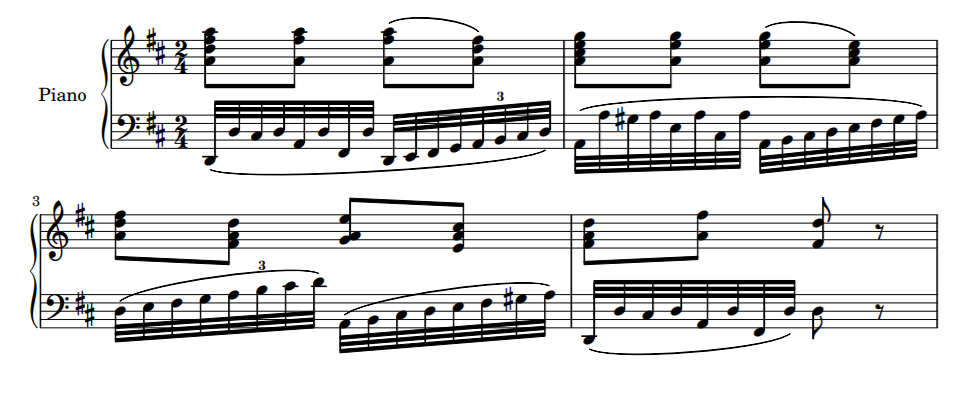
Rondo for Piano and Orchestra in D major, K. 382 (excerpt)
Using Mirror Image Mode, it could be played in the following way:
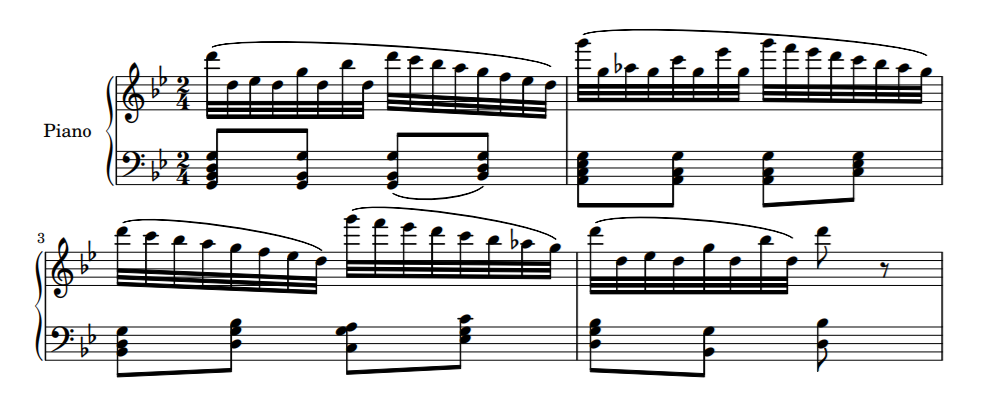
Rondo for Piano and Orchestra in D major, K. 382 (Symmetrical Inversion)
Conclusion
Symmetrical Inversion is a powerful practice technique for the piano because it allows us to work towards complete ambidexterity, while fostering novel inter-hemispheric coordination.
The Kundalini Piano Mirror helps to facilitate our journey into ambidexterity and full brain development by allowing symmetrically-inverted playing to produce aesthetically-pleasing musical outcomes.
Next Steps
- See online mirror image exercises using the Piano Mirror Online Score Viewer
- Shop for hardware
- View the provisional patent application for the Kundalini Software Mirror
- Browse the source code for this project on GitHub
- Download pre-compiled binaries (with an installer) for Windows
- Did you find a bug, or have an idea for an improvement? Use the issue tracker to report it!
- Checkout the Android version of this software, which is available through Google Play
- <coming soon> – Checkout the IOS version of this software
- Watch video explanations about this
The Kundalini Piano Mirror is dedicated to my teacher and friend Nicholas Constantinidis.